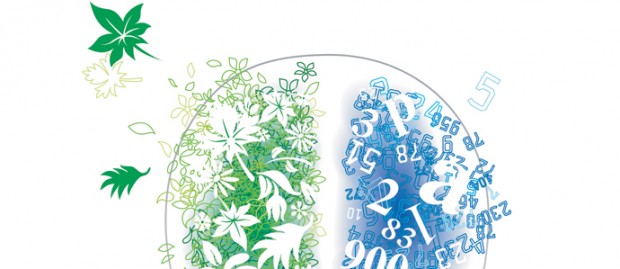Jonah Lehrer’s new book, Imagine: How creativity works claims to describe the cognitive process behind creativity so that it can be understood, learned and nurtured. Is this the stand-out work that finally nails the creative process?
I have not read the book yet, so I cannot say. However, I have read many reviews (see links below), I have listened to Start the Week on BBC4 (the entire content of which was based on creativity overseen by star guest Lehrer), I have read Wired’s feature article by Lehrer (The new rules of creativity – Wired April 2012) and I have even watched a flash animation introducing the book, with commentary by Lehrer himself.
The book is already a best seller and riding on a PR high. My observations are that this book might be engendering more interest in the phenomenon of Lehrer, than the phenomenon of creativity. Lehrer is clearly a bright young man. He honed his thoughts in neural labs of Columbia University. His first book Proust was a Neuroscientist explored the gap between the sciences and humanities. Imagine also attempts to bridge the rational with the artistic and has established Lehrer firmly as a new intellectual popular commentator – taking over the mantle from the likes of Malcolm Gladwell.
Lehrer bases his examination of creativity on empirical evidence gathered from scientific research on the brain including its opposing lobes and cortices. Yet we have known about right and left-sided thinking for some time and we have come to expect that the brain will process our imagination with myriad functional impulses. But does this knowledge help us be more creative?
Lehrer seems to be promising a series of scientific steps which will reveal how to be more creative, but apparently only provides a collection of evidences and observations about how and when creativity happens. The book includes many popular anecdotes on creativity: Bob Dylan as the archetype creative artist, or the ‘eureka-moment’ of the 3M Post-it note, or the impact of drugs on creativity – i.e. booze improves puzzle solving by 30%. This is a clever approach and will no doubt make the book an engaging read. However, some critics think that Lehrer is using his conclusions to serve his populist’s claims – and that they are nothing more than over-stated expressions of common sense.
And indeed, it does feel very familiar – there are no ‘ah-ha!’ moments of inspiration as far as I can tell. A big selling point of the book is that creativity is not a gift possessed by the lucky few – but a series of distinct thought processes that we can all learn. So it could be seen as a self-help book providing ideas for nurturing a creative environment in which we can boost our imagination. Below – is how Wired presents his ‘scientifically-proven’ ideas:
- Paint the walls blue – but how many of us work in primary-co loured rooms? Blue has associations with the sky and lazy summer days, so it is not a coincidence that I always seek the outdoors when contemplating pithy creative problems.
- Take more breaks – I.e. distract yourself. This allows a process of unconscious evaluation. Creatives do this instinctively.
- Think like a child – Michael Atavar’s book, ‘12 Rules of Creativity’ also understands this – his rule no. 3 is: ‘play’; by which he means get on the floor and play with toys. Picasso knew this, he said, “every child is an artist” As a child grows, they subsume their free imaginations in exchange for appearing more grown up and learning adult conformity. I.e. their left brain takes over from their right. All creatives deal instinctively with the stifling left brain. Most creative exercises focus on schemes to allow a reversion to intuitive (child-like) thinking.
- Watch more comedy – any creative would balk at a test designed to verify this claim – it would be a waste of time. John Heggarty in his book ‘Turning Intelligence into Magic’, cites comedy as an essential part of the creative process.
- Embrace your constraints – artistic constraints force us to think in more interesting and abstract ways. By this Lehrer means the restraining guidelines of poetry and Haikus – but creatives understand this to mean the products of applied creativity i.e. an ad, poster or video etc. Creatives have already learned to embrace constraints.
- Don’t brainstorm and work with strangers – Creatives know formal brainstorming does not work. But they also know that creativity comes about from interaction: so we have creative teams and we mix things up and expose our work to diverse stimuli. Lehrer’s issue is the first rule of brainstorming; ‘no criticism’. This is true – but all creatives know the first part of the creative process is to eliminate bad ideas – and thereafter to remain highly critical.
- Pretend it’s a dream/daydreaming – this again is a natural state for most creatives.
These ideas may sound rather radical to many readers – yet I do not find them surprising. Perhaps this book is not intended for practicing creatives – it would be preaching to the converted… I also wonder about how appropriate the presumed target audience is – readers from the corporate world. In the cut-and-thrust, cost-conscious world of business, how can you quantify the value of creativity? Can we really imagine the uptake of Lehrer’s principles? Could dynamic enterprises across the land unlock their staff’s true creative potential by having them work in teams of strangers, playing like children, watching comedy tv in a blue rooms – an environment where daydreaming is encouraged and and one is free to take as many breaks as one likes? Although, this may typify your average creative department, I doubt there are many organizations that will transform themselves into such models of creative unpredictability.
I believe that the strongest thread between all discourses on creativity – including Lehrer’s – is left brain vs right brain thinking – or in other words rational vs intuitive thinking. The creative process is about breaking down perceptions, challenging conformity, and shifting perspectives – all in an effort to allow the right brain to release its insights. John Heggarty’s book expresses the conundrum in its title – Turning Intelligence to Magic. (i.e. the intelligence of the rational planning department into the magic of the intuitive creative department). Further, he cites ‘irreverence’ as a consistent theme in his creative process. Surely this is another case of the right brain challenging the left’s conformity. Michael Atavar’s book 12 Rules of Creativity sets out what is essentially 12 ways to engage right and left thinking.
Most of Jonah Lehrer’s conclusions feel similarly intuitive. I doubt it will do anything to help one develop a great creative mind. What it appears to offer, however, is the familiar methodologies most creatives practice instinctively, such as how to get the creative juices flowing, how to overcome blocks, and how to create an environment or state of mind where one might hope inspiration will strike.
Imagine: How Creativity Works by Jonah Lehrer – review | Books | The Guardian
Jonah Lehrer: the prodigy who lights up the brain | profile | From the Observer



